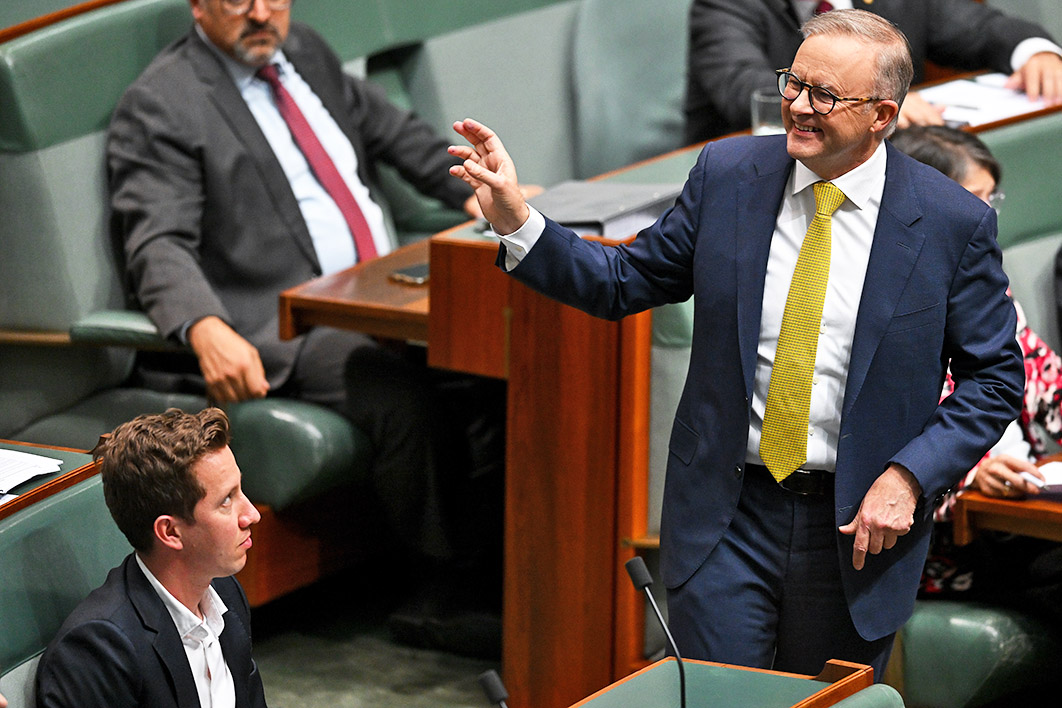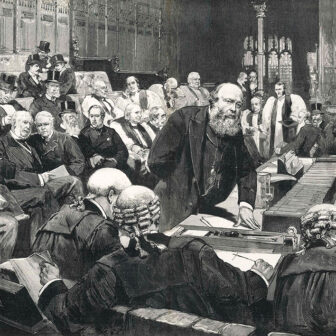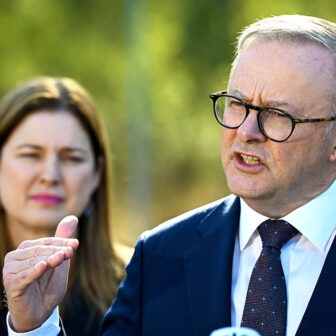After months of public brinkmanship, with interest groups and commentators barracking from the sidelines and the threat of a double dissolution election hanging overhead, the federal government has finally struck a deal with the Greens to legislate for the Housing Australia Future Fund. The fund was Labor’s centrepiece housing commitment during the 2022 election campaign and is intended to fund 30,000 new homes over five years.
In return for an extra $1 billion in social housing investment, the Greens dropped their demand that the bill include a two-year rent freeze, although housing spokesperson Max Chandler-Mather says the party is still committed to rent control and clearly sees this as a winning strategy in inner-urban seats.
“For us this fight has just started,” he told ABC Radio National Breakfast. “Nine months ago, no one cared about renters in the media and political establishment. Now they are a national news story.” The Greens had forced national cabinet to meet and discuss national renters’ rights, he said, referring to an August agreement by the states and territories to move towards a nationally consistent policy on tenancy laws.
National cabinet’s agreed measures would prevent landlords from terminating a lease without reasonable grounds or from raising rents more than once a year. They would also “phase in” minimum standards for rental properties — though the limp language doesn’t inspire great confidence that the lives of tenants will materially improve, especially given that the examples of “minimum standards” cited in the national cabinet communiqué are “stovetop in good working order, hot and cold running water.”
As well as setting up the HAFF, other bills before the Senate will create an independent body to provide housing research and advice to the federal government. The National Housing Supply and Affordability Council will fill an important gap created when the Abbott government abolished a similar body a decade ago.
Community housing activists have told me the Greens shouldn’t get all the credit for the progress, since the sector has also been lobbying hard, as has Labor for Housing and other ALP ginger groups. Other members of the Senate crossbench have been influential too.
Still, if the Greens hadn’t blocked the HAFF bill it’s hard to imagine that the government would have found an extra $3 billion to build homes for low-income Australians — the June commitment of a $2 billion social housing accelerator, and the additional $1 billion just announced. This new money will bolster the National Housing Infrastructure Facility and can be used to build new social and affordable homes or to pay for critical infrastructure needed to support them. The facility is administered by NHFIC, the National Housing Finance and Investment Corporation, which will become Housing Australia.
Under the original HAFF bill, the government set an annual cap of $500 million on disbursements from the fund to finance new homes. The Greens and other crossbench senators convinced the government to convert this ceiling into a floor — $500 million is now the minimum spend from the HAFF each year, rather than the maximum.
And independent senator David Pocock was also instrumental in getting these annual payouts indexed, which means their real value will be maintained over time rather than eroded by inflation.
The breakthrough on the HAFF is welcome news to not-for-profit housing providers. According to Wendy Hayhurst, chief executive of the Community Housing Industry Association, it will give the sector confidence to plan and deliver new homes.
Despite its designation as a “future fund,” though, the HAFF only offers five years of certainty. After that, there is no guarantee that more public funds will be available.
This isn’t the impression the government wants to give. In its issues paper promoting discussion of a new National Housing and Homelessness Plan it says the HAFF will “build 30,000 new social and affordable houses in its first five years” (my emphasis). Together with the name, this gives the impression that another 30,000 houses could be built in each of the subsequent five-year periods.
Housing minister Julie Collins has allowed this misapprehension to take hold by saying, for example, that “we’re talking about… a fund that in perpetuity each and every year would be delivering at least $500 million into social and affordable rental homes in Australia.”
At first glance, you might think that $500 million will be spent on new homes in every year of the fund’s twenty-five-year life. But that’s not how it works. Proceeds from the fund won’t provide up-front capital to finance new construction but will instead cover providers’ recurrent costs after the housing is built.
This is sometimes referred to as an “availability payment.” It’s essentially a subsidy to not-for-profit housing providers to bridge the gap between the cost of building and operating new homes and the low rents paid by social housing tenants. As a guaranteed future income flow it enables community housing organisations to raise commercial finance to build new dwellings. After five years almost all proceeds from the HAFF will be fully committed to covering the gap between housing providers’ costs and their rental income (at least until 2050).
The benefit of the model is that the HAFF leverages a modest amount of public money into larger sums of private capital. And once the funds are committed, it will be hard for the scheme to be undone by an incoming Coalition government: abolishing the scheme would mean interfering with commercial contracts.
But the HAFF is a complex way to fund housing. As business journalist Michael West writes, the biggest winners could be whoever manages the government’s investment. There’s a simpler alternative: as an analysis for the Australian Housing and Urban Research Institute concluded, “the cheapest and most efficient way to fund new social housing is direct public investment.” That’s why the Greens are crowing about directing an extra $3 billion from the government — six times the amount the HAFF will generate annually — straight into building new homes.
It’s certainly a good time to get money out the door. With the volatile construction sector heading for a downturn, this counter-cyclical release of new investment will help keep workers employed and firms afloat.
But all the extra investment will barely make a dent in the lack of rental homes for households on very low incomes. What is still sorely needed is a bipartisan commitment to financing new social housing for decades into the future.
The chances of that happening are slim. Shadow housing minister Michael Sukkar accused the government of waving the white flag on the great Australian dream because the HAFF does nothing for Australians who want to buy a home. In refusing to countenance support for the government’s social housing initiatives or engage with the struggles of renters, the opposition has dealt itself out of any role in tackling one of the nation’s most urgent challenges.
This leaves the Greens with a powerful hand in negotiations over other looming housing bills, including federal and state legislation to underpin Labor’s Help to Buy shared equity scheme, which is designed to help people into home ownership with a 2 per cent deposit.
The Greens demonstrated a tough pragmatism in the HAFF negotiations. As Chandler-Mather says, the media, the community housing sector and their fellow crossbenchers pressured the Greens for months to pass the bill without seeking further concessions. “We were told when we started this, that we were absurd and crazy, for pushing for more funding for public housing,” he said. “And look how far the debate has shifted.”
But it’s hard to see the party’s demand for a “rent freeze” gaining traction. The phrase promotes a binary understanding of rent control as a switch that is either on or off, rather than a dial that can be calibrated. It mobilises well-founded opposition based on evidence that blunt controls of this kind have unintended consequences.
As a report from the Centre for Equitable Housing notes, “hard” rent freezes, or “first generation” rent controls, have had negative effects elsewhere, deterring new housing investment and discouraging landlords from spending on maintenance. The report adds that a national one-size-fits-all rent freeze doesn’t account for regional differences and could drive some investors to switch their properties out of long-term rental and into short stays instead.
A range of more nuanced measures — what the report calls “second and third generation rent stabilisation” — could be used to moderate rent increases. These approaches, widely used in Europe, are more focussed on limiting rapid spikes than on bringing rents down overall. They may allow landlords to increase rents between tenancies, for example, or offer allowances for spending on maintenance.
The centre concludes that it is possible to develop rent stabilisation policies that allow the market “to play the defining role in setting rent prices but in a moderated and predictable fashion.”
The next test for Labor and the Greens will be whether they can move beyond the rent-freeze stand-off and begin a nuanced discussion about how to develop a more stable and affordable private rental market. That will require compromise on both sides. •




